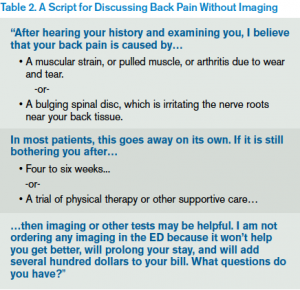

Explore This Issue
ACEP Now: Vol 33 – No 03 – March 2014Table 2. A Script for Discussing Back Pain Without Imaging
MRI is increasingly available in EDs nationwide, and its use has increased due to its lack of ionizing radiation and ability to image the spinal cord and nerve roots. However, it is time-intensive, limiting its applications in emergency care. In 2013, average Medicare costs for an MRI lumbar spine with and without contrast were $550 (range $166 to $2,022). MRI is the diagnostic modality of choice for patients in whom you suspect spinal-cord disorders such as cord compression, cauda equina, epidural abscess, or hematoma. For patients with a high clinical suspicion for these diagnoses, there is little utility to performing a preliminary X-ray or CT (if MRI is unavailable, you can substitute CT myelogram).
Patients may be seeking a fixable diagnosis when they request imaging, so a few minutes of education about the limited benefits and potential downsides of testing can improve both satisfaction and throughput. An example of how you might respond is shown in Table 2.
So the next time you see a patient with back pain with no high-risk findings, spend a few minutes discussing the diagnosis and plan with the patient. Reassurance and an outpatient regimen of over-the-counter analgesia and supportive care can reduce cost and length of stay—and, more important, are clinically effective.
 Dr. Lin is an attending emergency physician and a fellow in the Division of Health Policy Research and Translation in the Department of Emergency Medicine, Brigham and Women’s Hospital in Boston. She also serves as an instructor at Harvard Medical School.
Dr. Lin is an attending emergency physician and a fellow in the Division of Health Policy Research and Translation in the Department of Emergency Medicine, Brigham and Women’s Hospital in Boston. She also serves as an instructor at Harvard Medical School.
 Dr. Schuur is vice chair of quality and safety and chief of the Division of Health Policy Research and Translation in the Department of Emergency Medicine, Brigham & Women’s Hospital in Boston. He also serves as assistant professor at Harvard Medical School.
Dr. Schuur is vice chair of quality and safety and chief of the Division of Health Policy Research and Translation in the Department of Emergency Medicine, Brigham & Women’s Hospital in Boston. He also serves as assistant professor at Harvard Medical School.
References
- Friedman BW, Chilstrom M, Bijur PE, et al. Diagnostic testing and treatment of low back pain in United States emergency departments: a national perspective. Spine. 2010;35(24):E1406–1411.
- Chou R, Fu R, Carrino JA, et al. Imaging strategies for low-back pain: systematic review and meta-analysis. Lancet. 2009;373(9662):463–472.
- Davis PC, Wippold FJ 2nd, Brunberg JA, et al. ACR appropriateness criteria on low back pain. J Am Coll Radiol. 2009;6(6):401–7.
- Jensen MC, Brant-Zawadzki MN, Obuchowski N, et al. Magnetic resonance imaging of the lumbar spine in people without back pain. N Engl J Med. 1994;331(2):69–73.
- Borczuk P. An evidence-based approach to the evaluation and treatment of low back pain in the emergency department. Emerg Med Pract. 2013;15(7):1–23.
- Nachemson A. The lumbar spine: an orthopedic challenge. Spine. 1976;1:59-71.
Pages: 1 2 3 | Single Page







2 Responses to “A High-Value Diagnostic Approach to Low-Back Pain”
July 1, 2015
ACR Study Finds ER Imaging for Low-Back Pain Appropriate | Advantedge Newsletter[…] Lin, MD, MPH, Michelle and Schur, MD, MHS, Jeremiah D., “A High Value Diagnostic Approach to Low-Back Pain,” ACEP Now, March 7, […]
July 2, 2015
ACR Study Finds ER Imaging for Low-Back Pain Appropriate | Emergency Medicine[…] Lin, MD, MPH, Michelle and Schur, MD, MHS, Jeremiah D., “A High Value Diagnostic Approach to Low-Back Pain,” ACEP Now, March 7, […]